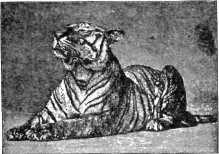TIGLATH PILESER 1912
Description
This page of the book is from "The New Student's Reference Work: Volume 4" by Chandler B. Beach, Frank Morton McMurry and others.
TIGLATH PILESER
1912
TILLMAN
The tiger's jaws and teeth crush the large bones of a buffalo, and it can break a horse's back with one blow of the forepaw. It is audacious, cunning, treacherous, the fiercest and most bloodthirsty of beasts. The kittens are about a foot long when born; they remain with the mother until the third year. The tigress teaches the young how to find and kill prey. They stalk their prey, and also spring upon it
from ambush. A cattle-eating tiger will kill an ox about every five days or from sixty to seventy in a year. Hunting the tiger from the backs of elephants is dangerous and exciting. The range of the tiger is greater than was at first supposed. Starting with India as its chief locality, it ranges west through Persia, east through Burma to Sumatra and Java and north through China to Manchuria and even into Siberia. It is absent from Ceylon and Borneo.
Tig'lath Pile'ser. See Assyria.
Ti'gris, a large river of Asiatic Turkey, rises south of Lake Goljik in the Kurdish Mountains, is joined at Til by the Bitlis, unites with its sister-stream, the Euphrates (q. v.), at Korna, and from this point to the Persian Gulf is known as the Shat-el-Arab. Its whole course is some 1,500 miles long. In its upper part it is a very swift stream. The Tigris in ancient times was the great river of Assyria, and formed the eastern border of Mesopotamia. Nineveh, Seleucia and Ctesiphon stood on its banks. Its chief cities now are Baghdad, Mosul and Diarbekir. It is navigable for steamers at all "seasons below Mosul.
Til'den, Samuel Jones, was born at New Lebanon, N. Y., Feb. 9, 1814. He went to Yale College and the University of New York, and became a lawyer. As a member of New York Assembly in 1846 he was much interested in the state canals, and became one of the leading Democrats of the state. In 1874 Tilden was elected governor by 50,000 majority, and his popularity, thus shown, gave him the Democratic nomination for the presidency
in 1876. The Hayes-Tilden campaign was one of the hardest-fought and closest in our history, and the disputed election was given Hayes by the electoral commission of 15 appointed by congress to canvass the votes. Tilden also was a prominent lawyer of New York City. He was one of the organizers of the bar-association, and was leading counsel in many large cases. He died near Yonkers, N. Y., Aug. 4, 1886, leaving the bulk of his fortune to found a free library for New York City. See New York Library.
Tiles. A tile is a slab of baked clay, used for covering roofs, paving floors, lining furnaces, constructing drains and for decorative purposes. The general process of manufacture involves preparing, mixing, molding and firing the clay, after which it may be polished. Fire-proof and structural tile is coming into extensive use; there are three classes : dense, porous and semiporous. The latter two are made by mixing the clay with straw, sawdust or fine coal. The porous tile can be nailed to and cut with a saw. The decorative value of tiling is seen chiefly in flooring. The body of the tile is made of one color of clay and the inlaid pattern of another. Many times figures are put on in slight relief. Tiles made in Cairo and Damascus in medieval times are of such beauty that squares of nine or sixteen are often sold for many hundreds of dollars.
Til'ley, Sir Samuel Leonard, was born in New Brunswick in 1818. He was a member of the Executive Council of New Brunswick from 1854 to 1856 and from 1857 to 1865, from 1866 until the Union holding the office of Provincial Secretary. He was frequently a delegate to England; a delegate to the Charlottetown and Quebec Conferences in 1864 and to the London Colonial Conference in 1866. He was Minister of Finance on two occasions, and was Lieutenant-Governor of New Brunswick from 1873 ^° 1878. He was returned to the House of Commons in 1878 and reelected the following term. When a private member he carried the prohibitory liquor-law through the New Brunswick Assembly. He is one of the fathers of Canadian federation.
Till'man, Benjamin Ryan, was born in Edgefield County, South Carolina, on Aug. 11, 1847. He was educated at Bethany Academy, but his studies were interrupted by the Civil War. He joined the Confederate army in July of 1864, but a severe sickness cost him an eye and invalided him for two years. During the time of reconstruction (q v.) he was active in promoting education and became politically prominent, but followed farming as his sole pursuit until 1886. Then he was a leader of the agitation for educational, industrial and other reforms and in the opposition of the Democratic

TIGER


